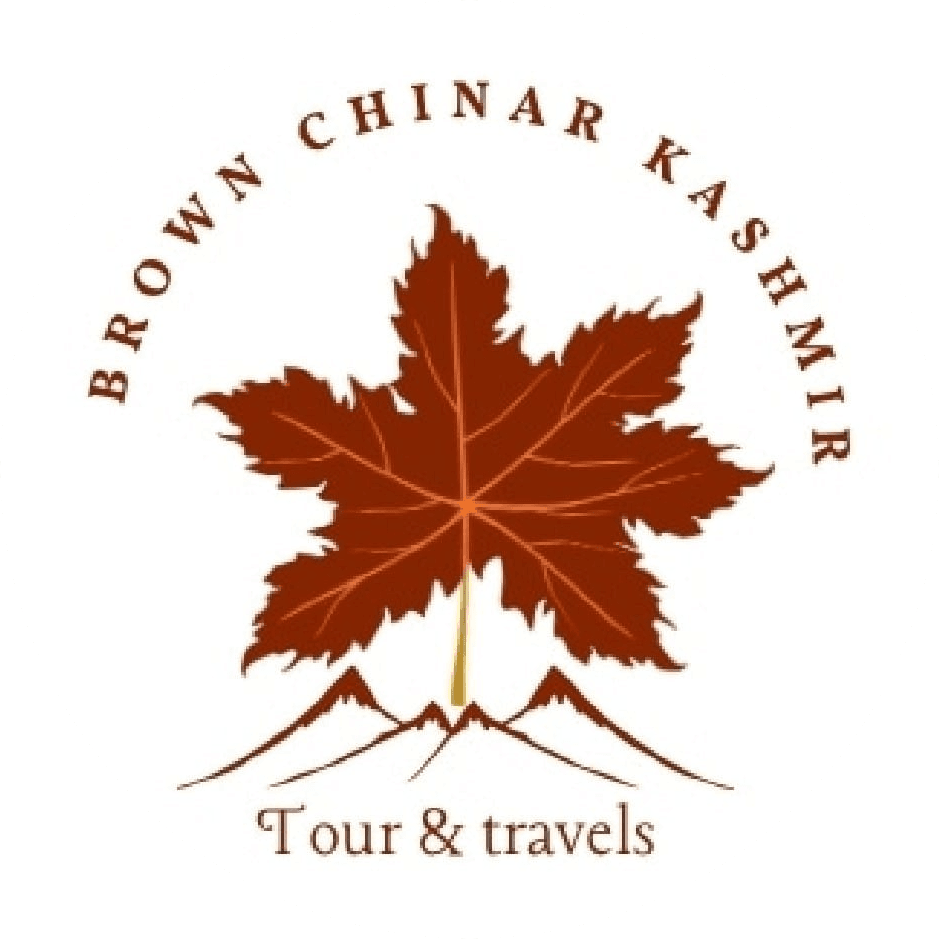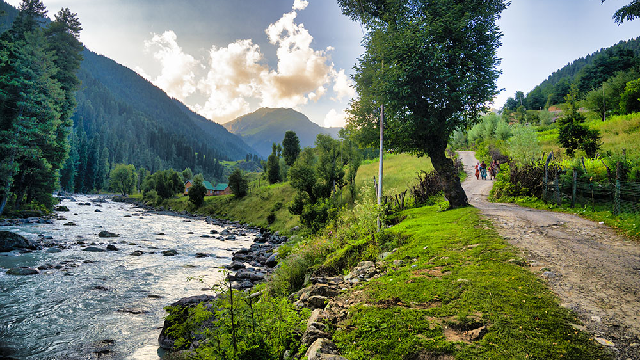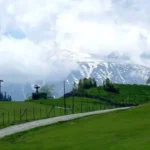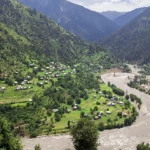Table of Contents
Toggle- Overview
- Location and Geography of Aru Valley
- The Alluring Seasons of Aru Valley
- How to Reach Aru Valley
- Best Things to Do in Aru Valley
- Where to Stay in Aru Valley
- Traveling Tips to Visit Aru Valley
- Conclusion
- How to book Aru Valley tour online?
- People Also Ask
- What is Aru Valley?
- How far is Aru Valley from Pahalgam?
- What is the best time to visit Aru Valley?
- How can I reach Aru Valley?
- What are the popular trekking routes in Aru Valley?
- Is Aru Valley safe for tourists?
- Are there any wildlife or bird-watching opportunities in Aru Valley?
- What is the best way to travel around Aru Valley?
- Can I go fishing in Aru Valley?
- Is camping allowed in Aru Valley?
- What are the local cuisines of Aru Valley?
- Can I visit Aru Valley during winter?
- What are the cultural attractions in Aru Valley?
- How long does it take to trek to Lidderwat from Aru?
- Is there accommodation available in Aru Valley?
- What should I pack for a trip to Aru Valley?
- What is the altitude of Aru Valley?
- Are there any adventure activities other than trekking in Aru Valley?
- Can I visit Aru Valley as a solo traveler?
- What are the best photography spots in Aru Valley?
- Are there any cultural festivals celebrated in Aru Valley?
- What is the weather like in Aru Valley?
- Are there any public transportation options to Aru Valley?
- How can I book a trekking tour to Aru Valley?
- What makes Aru Valley different from other tourist destinations in Kashmir?
- Inquiry Form
Overview
Located in the lap of mighty Himalayan ranges, Aru Valley is one of the best-kept secrets of Kashmir. This far-off valley lies just a few miles from Pahalgam in the Indian-administered region of Jammu and Kashmir and represents a place unmatched in natural beauty and peace. Lush meadows, sparkling rivers, snow-capped peaks, and rich cultural heritage all make Aru Valley a haven for a quiet retreat from the chaos of city life.
Aru Valley is often overshadowed by the more famous neighbors of Gulmarg and Sonamarg. However, it is a perfect place for nature lovers, adventure seekers, and those seeking peace and solitude because of its unspoiled landscapes, lush forests, and charming rural life. It promises an unforgettable experience for whether you are an experienced trekker or a casual traveler seeking a peaceful retreat.
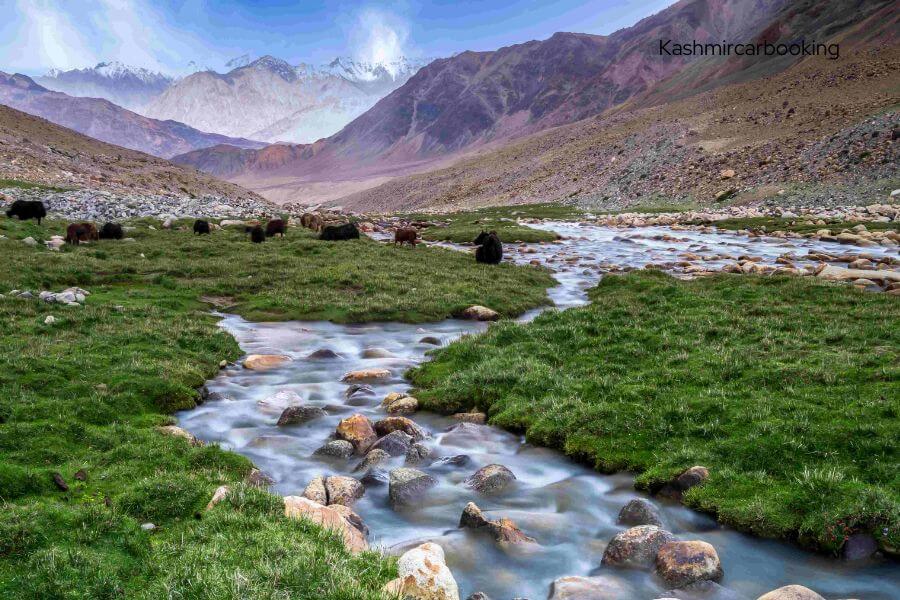
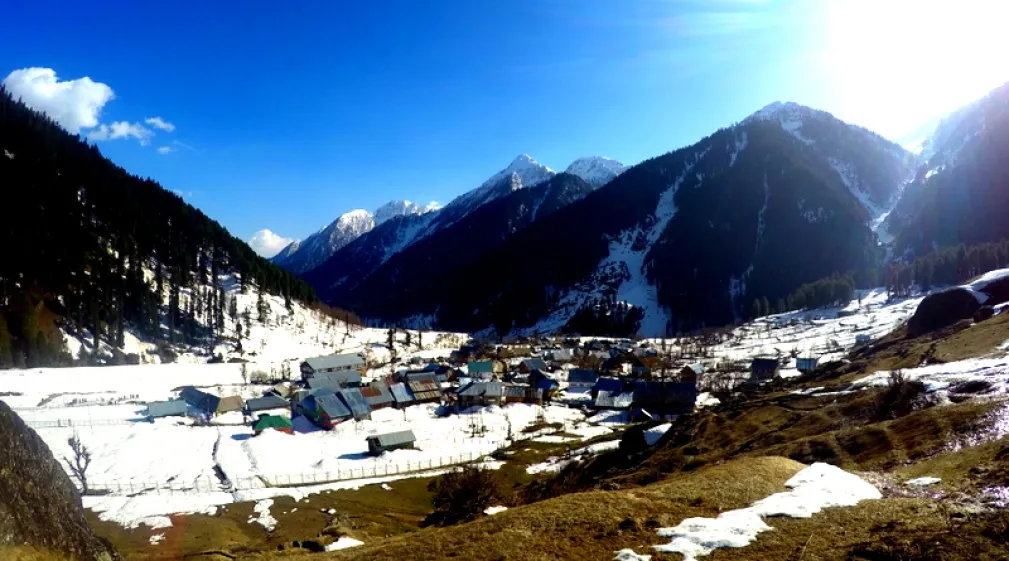
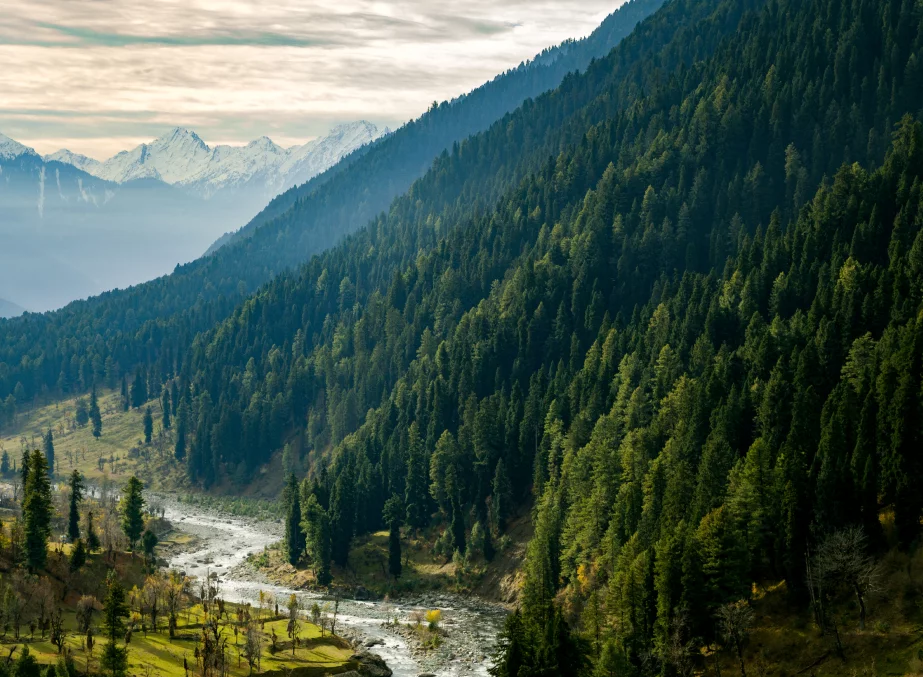
Location and Geography of Aru Valley
Aru Valley is at the foot of the highest peak, Kolahoi Peak, in the Kashmir Valley. The valley is approximately 12 kilometers from the town of Pahalgam, popularly known as one of the main tourist destinations in Jammu and Kashmir. Aru is a tiny but beautiful village, often termed as a gateway to several trekking trails, alpine lakes, and unexplored wilderness.
This area is geographically blessed, from lush meadows to thick forests and even alpine lakes. That alone is matched with snow-clad mountain ranges; on its way down from the Kolahoi Glacier comes the Lidder River, thus enhancing the natural charm of this place. In that sense, a hidden paradise because mass tourism never touches this valley, thus one can really discover a serene landscape untouched in time.
The Alluring Seasons of Aru Valley
Aru Valley attracts tourists with a change in landscapes according to different seasons. In every season, the valley possesses a different kind of character which makes it one of the desirable places throughout the year.
Summer: A Lush Green Carpet and Pleasantly Warm Weather
Aru valley is at its greenerest between May and August. Wildflowers occupy the mountains in a spectacular color, while melting snow from surrounding peaks makes the blue clear skies and cooler temperatures. This is the perfect time to visit if you’re interested in greenery of the valley and want to have a great time trekking and camping in this place. Summer has temperatures ranging between 15°C to 30°C.
Summer is also the time that treks in Lidderwat and up to the Kolahoi Glacier become more productive. Aru Valley attracts adventure lovers to trek for multiple days within dense forests while crossing alpine lakes.
Autumn: Colour Burst
The valley looks as if it has been painted during these months of September to November. The leaves start getting tints of golden, orange, and red, offering a vivid tapestry of autumn. Photographers and nature enthusiasts throng the valley more for the spectacular view that only Aru Valley can offer on this autumn, making it a site straight out of a painting. It is the season for trekkers with just enough gentle softness to the atmosphere, and colors all around give each step its pleasure.
Winter: A Paradise Snow-Capped
Winter in Aru Valley (December to February) is like a fairy tale. The valley is entirely covered with a thick layer of white snow, it becomes a winter wonderland. Every meadow under the sun covered with snowflakes, ice-covered rivers along with towering backdrops of immense mountains, painting an other-worldly and picture-perfect atmosphere. Although it gets a bit cold in winters at the Aru Valley with mercury going down below the freezing point quite often, it still remains to be an ideal season to visit Aru Valley, especially for those who can appreciate the beautiful landscape of winter. It happens to be the lesser-known tourist season, hence giving people silence that they are longing to enjoy during those crammed tour destinations.
It’s the season when the climate is going to be perfect for trekking into the snows and clicking some lovely photography. Other winter sports such as skiing and snowboarding can also be indulged in nearby destinations. The valley offers the ultimate winter destination during this serene setting and natural environment.
Spring: When Nature Awakens
Spring (March to April) is the season when the valley blooms after an extended winter period. In this thawing of snow, wild flowers bloom all across the meadows, and verdant green starts to emerge at the valley. The spring weather is mild at 5 to 15 degree Celsius, hence a very great time to travel. Though not as busy during the trekking season as summer, spring presents a serene silence for a soothing holiday.
How to Reach Aru Valley
Aru Valley is well connected to major towns and cities in Jammu and Kashmir. So, reaching the valley from anywhere in the country is not too difficult. Given below are the different means through which you can reach Aru Valley:
By Air: The Nearest Airport
The nearest airport to Aru Valley is Sheikh ul-Alam International Airport (Srinagar Airport). It lies at a distance of about 90 kilometers from the valley. From the airport, there are frequent flights to the other major cities, such as Delhi, Mumbai, and Bengaluru. From the airport itself, you can take a taxi or board a bus to Pahalgam, which is the nearest town. From Pahalgam, you can take a taxi or jeep to Aru Valley, which is 12 kilometers away.
By Train: Jammu to Aru Valley.
The nearest railway station to Aru Valley is the Jammu Tawi Railway Station, which is 250 kilometers from the valley. Jammu Tawi is one of the major railway junctions in North India and is very well connected to Delhi, Mumbai, Kolkata, and Chandigarh. From Jammu, you can take a taxi or a bus to reach Pahalgam. From Pahalgam, you can easily reach Aru Valley by road.
By Road: A Scenic Drive
If people love traveling across roads, then there is an open possibility of traveling on roads to get to Aru Valley. Since the roads connected to Srinagar and Pahalgam well-paved, then from Srinagar, taxis or cars to Pahalgam are used, and driving 12 kms from Pahalgam via a scenic approach leads to this valley. These roads are accompanied by views, which will also travel through the different landscapes that border the journey between Kashmir Valley.
Best Things to Do in Aru Valley
Aru Valley has something for everyone: an adventure-seeker, a photographer, or a relaxing time. Activities in the valley range from trekking and camping to fishing and bird watching. Below are the top activities you can enjoy in Aru Valley:
- Trekking and Hiking
It is very famous for the trekking trails that are offering some of the best Himalaya and Kashmir views of virgin, untouched wilderness. Some popular routes for trek from Aru Valley are as under:
- Aru to Lidderwat Trek: This is a moderately challenging trek that takes you through the lush meadows, thick forests, and along the gurgling streams to the beautiful Lidderwat Lake, skirted by snow-capped peaks. The total duration for this trek would be 2-3 days, with some of the best valley views.
- Trek to the Kolahoi Glacier: Although this is the second biggest glacier in Kashmir, from this trek’s top, you can see the panoramic view of peaks. Only for the experienced ones, it is a trek.
- Aru to Sonmarg Trek: The trek offers the best methods of exploring the alpine meadows and glaciers of the valley of Kashmir. It connects Arue Valley with Sonmarg, which can be termed as one of the popular destinations in terms of beauty. It is well suited for all those people who would like to have a long trek with varied conditions.
- Fishing and Angling
The Lidder River flowing through Aru Valley stands as one of the best places in the world to fish and be an angler. The species of fish running in the water include trout among others. For anglers, this is surely a heaven like place. Even you can spend your whole day sitting beside it or even more, hire any local guide here who will coach you to take the art of fishing in its pristine waters.
- Camping in the Wilderness
The other great way to view the beauty of Aru Valley is through camping. There are camps around the trek routes, where one can spend night amidst stars. The Lidderwat area has very beautiful scenery; the most popular place for camping is the Lidderwat area. Any camper will experience this unique place due to the tranquil atmosphere surrounding it.
- Bird Watching and Wildlife Observation
This is any ornithologist and wildlife lover’s heaven. With various species in the offer, this allows the state bird of Jammu and Kashmir-the Himalayan Monal. Provided one is a bit lucky, one can find wild animals ranging from the Himalayan brown bear to the musk deer with the snow leopard. The peaceful activity offers enough scope to stay connected with the nature and have a glimpse into the magnificence at Aru Valley.
- Photography
It’s heaven for a photographer, as one has thousand and one scopes for snapping pictures of nature. Either springtime in Aru valley full of grass meadows or vibrant autumn leaf hues or a whole white environment due to the onset of winter-in any of the seasons, one will not feel a want to take picture frames here. Scenes like the peak of Kolahoi, the Lidder river, or an alpine lake will indeed spellbind the observer.
- Cultural Experience
Aru Valley is very cultured because the predominant people there generally belong to Gujjars and Bakarwals tribes and are known experienced as life time shepherd and time cowherd. It gets the experience by meeting locals whereby one would gather some insight or glimpse into those ancient customary ways of living or practicing customs/rituals of the society of Kashmir valley. Some of the utmost dishes are Rogan Josh, Yakhni, and Gustaba, along with many more, which are prepared from a unique blend of spices.
Where to Stay in Aru Valley
Aru Valley is not very commercialized, and therefore one may find accommodations here according to their budget requirement. These vary from budget guesthouses to luxury resorts and campsites.
- Guesthouses and Hotels
There are a few guesthouses and small hotels in the vicinity of the valley. These are a bit crude but clean places. These places provide a bare minimum set-up, but the serenity around and the amity of the local people are more than enough compensation. Accommodations in such guesthouses provide a chance to mix with the local people and experience the hospitality of Kashmir.
- Camping
It has trekking in the Aru valley. The entire region can be covered very easily because trekking operators offer very organized camping tour options along various popular trekking routes such as Lidderwat, or Kolahoi Glacier. Tent camps can even be set up outside the homesteads and that is a more direct means which allows you to get inside the wild very directly.
- Homestays
Stay in a homestay local. The traditional way of Kashmiri life can be experienced in stay in a local homestay, stay in homestays offered by many local families in Aru to stay in cozy rooms and eat home-cooked meals. This option provides an extremely intimate experience, the best for the those who want to understand the local culture.
Traveling Tips to Visit Aru Valley
- Pack accordingly: The weather in Aru Valley can change in a short time, and if you are trekking, it is worse. Pack warm and waterproof clothes, sturdy trekking shoes, and other outdoor essentials.
- Health and Safety: Carry a first-aid kit, medications for altitude sickness, especially if you plan on trekking to higher altitudes. Keep bottled water with you; untreated water can cause you to fall sick.
- Respect Local Culture: The Aru Valley presents a lifestyle that very aptly belongs to the traditional Kashmir. Learn to appreciate the local traditions and ways, especially concerning countryside villages and their daily lives.
- Permits: Some trekking routes are permit-driven, especially if you have visions of trekking close to the borders. Ensure that you get the right documents from the local authorities or your travel operator.
Conclusion
It caters to all and each one, be it an adventurer, a nature lover, or a soul searching for peace. Its unexploited beauty, stunning landscapes, rich culture, and warm hospitality make it one of the most enchanting places in the Kashmir Valley. Whether you trek through its alpine meadows, fish in Lidder River, or just relax and absorb the serene environment, Aru Valley will win your heart to this place. Plan your visit to this little hidden gem and experience for yourself the difference that Aru Valley entails.
How to book Aru Valley tour online?
Contact Brown Chinar at +91 6005039532/+91 9906188874 or Email us at : Enquiry@brownchinarkashmir.com
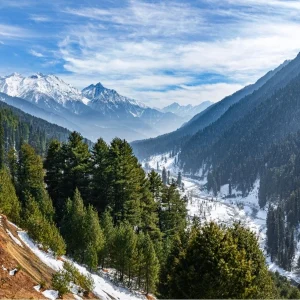
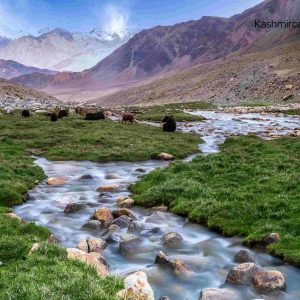
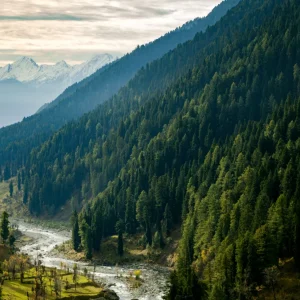

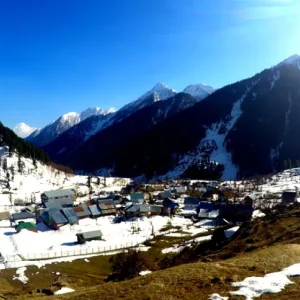
People Also Ask
What is Aru Valley?
Aru Valley is a beautiful, serene valley located in Jammu and Kashmir, India. It is known for its stunning landscapes, including lush meadows, dense forests, and snow-capped mountains. The valley is a popular destination for trekking, camping, and nature lovers.
How far is Aru Valley from Pahalgam?
Aru Valley is located about 12 kilometers from Pahalgam, which is one of the popular tourist destinations in Kashmir. The valley is easily accessible by road from Pahalgam.
What is the best time to visit Aru Valley?
The best time to visit Aru Valley depends on the season you prefer. For lush greenery and pleasant weather, visit during summer (May to August). Autumn (September to November) is ideal for photographers, while winter (December to February) is perfect for snow lovers.
How can I reach Aru Valley?
Aru Valley can be accessed by air, rail, and road. The nearest airport is in Srinagar, and the nearest railway station is Jammu. From both, you can take a taxi or bus to Pahalgam and then a short drive to Aru Valley.
What are the popular trekking routes in Aru Valley?
Some of the most popular trekking routes in Aru Valley include the Aru to Lidderwat Trek, Aru to Kolahoi Glacier Trek, and the Aru to Sonamarg Trek. These treks offer stunning views of glaciers, rivers, and snow-capped mountains.
Is Aru Valley safe for tourists?
Yes, Aru Valley is generally safe for tourists. However, it’s always important to check weather conditions, follow safety guidelines, and take local advice before embarking on treks or outdoor activities.
Are there any wildlife or bird-watching opportunities in Aru Valley?
Yes, Aru Valley is home to a variety of wildlife, including the Himalayan brown bear, snow leopard, and musk deer. It’s also a haven for birdwatchers, with species like the Himalayan Monal, the state bird of Jammu and Kashmir, and other migratory birds.
What is the best way to travel around Aru Valley?
The best way to travel around Aru Valley is by foot or jeep. Many trekking routes start from Aru, and jeeps are available for short rides to various points in the valley.
Can I go fishing in Aru Valley?
Yes, the Lidder River that flows through Aru Valley is ideal for fishing. It is famous for trout fishing, and you can hire local guides to assist you.
Is camping allowed in Aru Valley?
Yes, camping is allowed in Aru Valley. Popular camping sites include Lidderwat and Kolahoi Glacier areas, where you can set up tents and spend the night under the stars.
What are the local cuisines of Aru Valley?
Kashmiri cuisine is a highlight of Aru Valley. You can enjoy dishes like Rogan Josh, Yakhni, Gushtaba, and Kahwa (a traditional green tea). These dishes reflect the region’s rich cultural heritage.
Can I visit Aru Valley during winter?
Yes, Aru Valley is a beautiful winter destination. It transforms into a snow-covered paradise, offering opportunities for snow trekking, photography, and enjoying the serene winter landscape.
What are the cultural attractions in Aru Valley?
Aru Valley is home to various ethnic groups, including Gujjars and Bakarwals, whose lifestyle and traditions are deeply connected to the land. You can explore the rural culture, visit local villages, and experience Kashmiri hospitality.
How long does it take to trek to Lidderwat from Aru?
The trek to Lidderwat from Aru Valley usually takes around 2-3 days, depending on your pace and the weather conditions. The trek is moderate in difficulty and offers incredible views of the surrounding mountains.
Is there accommodation available in Aru Valley?
Yes, there are various accommodation options in Aru Valley, including guesthouses, homestays, and campsites. Staying in a local homestay offers an authentic experience of Kashmiri hospitality.
What should I pack for a trip to Aru Valley?
For a trip to Aru Valley, pack warm clothing (even in summer), trekking shoes, a raincoat, sunscreen, a camera, and other necessary trekking gear. Be sure to carry a first-aid kit and a water bottle as well.
What is the altitude of Aru Valley?
Aru Valley is located at an altitude of around 2,400 meters (7,874 feet) above sea level. This makes it an excellent location for trekking and other high-altitude activities.
Are there any adventure activities other than trekking in Aru Valley?
Apart from trekking, visitors to Aru Valley can indulge in activities like fishing, camping, wildlife photography, birdwatching, and snow sports like skiing (during winter).
Can I visit Aru Valley as a solo traveler?
Yes, Aru Valley is ideal for solo travelers. It’s a peaceful destination, and the routes are well-marked, making it suitable for solo trekkers and travelers looking for solitude.
What are the best photography spots in Aru Valley?
Some of the best photography spots in Aru Valley include the Kolahoi Glacier, Lidderwat Lake, Sonamarg, and the various meadows and rivers in the valley. The landscape provides excellent opportunities for landscape and wildlife photography.
Are there any cultural festivals celebrated in Aru Valley?
While Aru Valley is not known for large-scale festivals, visitors can witness traditional Kashmiri festivals like Eid, Navroz, and Kashmiri New Year (Chet) when visiting local villages. These festivals offer a great insight into Kashmiri traditions.
What is the weather like in Aru Valley?
The weather in Aru Valley varies depending on the season. Summers are pleasant and cool, with temperatures ranging from 15°C to 30°C. Winters are cold, with temperatures often dipping below freezing and snow covering the area.
Are there any public transportation options to Aru Valley?
Public transportation options to Aru Valley are limited. However, you can take a bus or a shared taxi from Srinagar or Pahalgam to reach Aru Valley. For more convenience, hiring a private taxi or jeep is recommended.
How can I book a trekking tour to Aru Valley?
You can book a trekking tour to Aru Valley through various local trekking agencies or online platforms. Many tour operators offer guided trekking packages, including transportation, permits, and camping arrangements.
What makes Aru Valley different from other tourist destinations in Kashmir?
Aru Valley is less commercialized than other famous tourist spots in Kashmir, making it a peaceful and untouched destination. Its pristine beauty, fewer crowds, and excellent trekking routes set it apart from other locations in the region.
